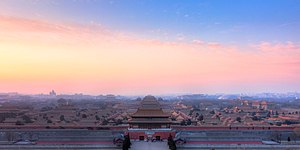
Back Verbode Stad Afrikaans المدينة المحرمة Arabic Ciudá Prohibida AST Yasaq şəhər Azerbaijani یاساق شهر AZB Забаронены горад Byelorussian Забранен град Bulgarian নিষিদ্ধ নগরী Bengali/Bangla Keoded difennet Breton Zabranjeni grad BS
 The Forbidden City viewed from Jingshan Hill | |
| Established | 1406–1420 1925 (as public museum) |
|---|---|
| Location | 4 Jingshan Front St, Dongcheng, Beijing, China |
| Coordinates | 39°54′57″N 116°23′27″E / 39.91583°N 116.39083°E |
| Type | Art museum, Imperial palace, Historic site |
| Visitors | 16.7 million[1] |
| Curator | Wang Xudong |
| Area | 72 hectares |
| Built | 1406–1420 (Ming dynasty) |
| Architect | Kuai Xiang |
| Architectural style(s) | Chinese architecture |
| Website | intl www |
| Part of | Imperial Palaces of the Ming and Qing Dynasties in Beijing and Shenyang |
| Criteria | Cultural: i, ii, iii, iv |
| Reference | 439-001 |
| Inscription | 1987 (11th Session) |
| Forbidden City | |||||||||||||||||||||||||||||
|---|---|---|---|---|---|---|---|---|---|---|---|---|---|---|---|---|---|---|---|---|---|---|---|---|---|---|---|---|---|
 "Forbidden City" in Chinese characters | |||||||||||||||||||||||||||||
| Chinese name | |||||||||||||||||||||||||||||
| Chinese | 紫禁城 | ||||||||||||||||||||||||||||
| Literal meaning | "Purple Forbidden City" | ||||||||||||||||||||||||||||
| |||||||||||||||||||||||||||||
| Manchu name | |||||||||||||||||||||||||||||
| Manchu script | ᡩᠠᠪᡴᡡᡵᡳ ᡩᠣᡵᡤᡳ ᡥᠣᡨᠣᠨ | ||||||||||||||||||||||||||||
| Romanization | dabkūri dorgi hoton 'Former inner city' | ||||||||||||||||||||||||||||
The Forbidden City (Chinese: 紫禁城; pinyin: zǐ jìn chéng) is a palace complex in Dongcheng District, Beijing, China, at the center of the Imperial City of Beijing. It is surrounded by numerous opulent imperial gardens and temples including the 22 ha (54-acre) Zhongshan Park, the sacrificial Imperial Ancestral Temple, the 69 ha (171-acre) Beihai Park, and the 23 ha (57-acre) Jingshan Park.[2] It is officially administered by the Palace Museum.
The Forbidden City was constructed from 1406 to 1420, and was the former Chinese imperial palace and winter residence of the Emperor of China from the Ming dynasty (since the Yongle Emperor) to the end of the Qing dynasty, between 1420 and 1924. The Forbidden City served as the home of Chinese emperors and their households and was the ceremonial and political center of the Chinese government for over 500 years. Since 1925, the Forbidden City has been under the charge of the Palace Museum, whose extensive collection of artwork and artifacts was built upon the imperial collections of the Ming and Qing dynasties. The Forbidden City was declared a World Heritage Site in 1987.[3]
The complex claims to consist of 9,999.5 buildings in total, although experts have shown in recent years that the number only amounts to 8,704,[4] encompassing 9,999 rooms and covering 720,000 m2 (72 ha)/178 acres.[5][6] The palace exemplifies the opulence of the residences of the Chinese emperor and the traditional Chinese palatial architecture,[3] and has influenced cultural and architectural developments in East Asia and elsewhere. It is listed by UNESCO as the largest collection of preserved ancient wooden structures in the world. Since 2012, the Forbidden City has seen an average of 14 million visitors annually, and received more than 19 million visitors in 2019.[7] In 2018, the Forbidden City's market value was estimated at US$70 billion, making it both the world's most valuable palace and the most valuable piece of real estate anywhere in the world.[8]
The Forbidden City in Beijing is one of the largest and most well-preserved wooden structures in the world. It was listed as the first batch of national key cultural relics in 1961.[9]
- ^ 故宫2017年接待观众逾1699万人次 创历史新纪录 (in Chinese). 31 December 2017. Archived from the original on 25 March 2018. Retrieved 24 March 2018.
- ^ "Symbolism in the Forbidden City: The Magnificent Design, Distinct Colors, and Lucky Numbers of China's Imperial Palace". Association for Asian Studies. Archived from the original on 18 November 2021. Retrieved 18 November 2021.
- ^ a b "UNESCO World Heritage List: Imperial Palaces of the Ming and Qing Dynasties in Beijing and Shenyang". UNESCO. Archived from the original on 5 May 2007. Retrieved 4 May 2007.
- ^ 故宫到底有多少间房 [How many rooms in the Forbidden City] (in Simplified Chinese). Singtao Net. 27 September 2006. Archived from the original on 18 July 2007. Retrieved 5 July 2007.
- ^ Lu, Yongxiang (2014). A History of Chinese Science and Technology, Volume 3. New York: Springer. ISBN 978-3-662-44163-3.
- ^ "Advisory Body Evaluation (1987)" (PDF). UNESCO. Archived (PDF) from the original on 2 November 2015. Retrieved 25 February 2016.
- ^ "1900万!故宫年客流量创新高-新华网". www.xinhuanet.com. Archived from the original on 6 December 2020. Retrieved 21 January 2020.
- ^ "How much the world's most valuable palaces are worth". MSN.com. Archived from the original on 10 January 2021. Retrieved 10 December 2020.
Forbidden City, China – $69.66 billion+ (£54bn+). The crown jewel of Beijing, the Forbidden City was the residence of the Chinese emperors and the locus of government from 1420 to 1912. Now a museum, the complex was declared a UNESCO World Heritage Site in 1987.
- ^ Centre, UNESCO World Heritage. "Imperial Palaces of the Ming and Qing Dynasties in Beijing and Shenyang". UNESCO World Heritage Centre. Archived from the original on 2 December 2021. Retrieved 1 December 2021.
© MMXXIII Rich X Search. We shall prevail. All rights reserved. Rich X Search

